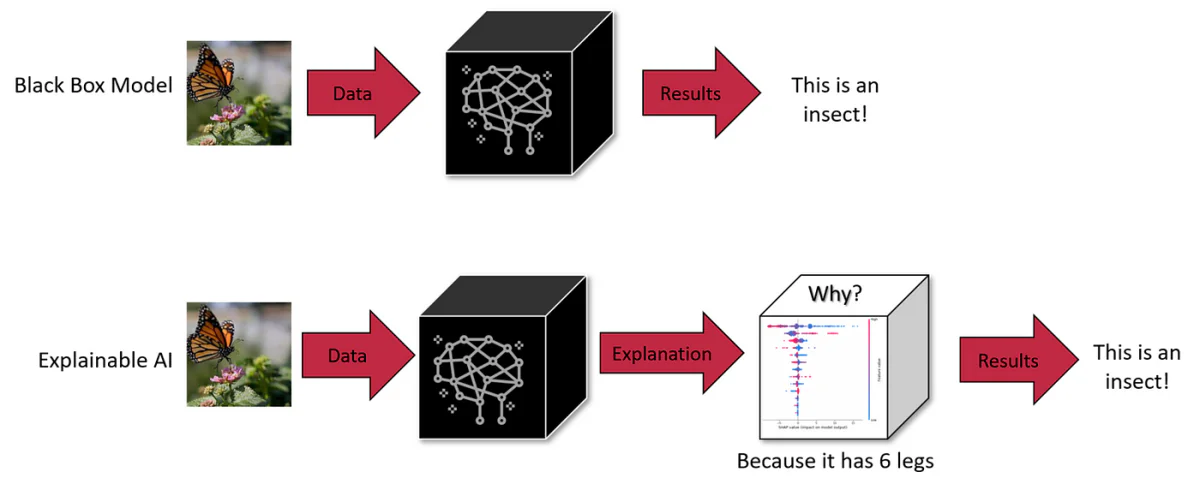Artificial Intelligence
The Black Box Problem in LLMs: Challenges and Emerging Solutions

Machine learning, a subset of AI, involves three components: algorithms, training data, and the resulting model. An algorithm, essentially a set of procedures, learns to identify patterns from a large set of examples (training data). The culmination of this training is a machine-learning model. For example, an algorithm trained with images of dogs would result in a model capable of identifying dogs in images.
Black Box in Machine Learning
In machine learning, any of the three components—algorithm, training data, or model—can be a black box. While algorithms are often publicly known, developers may choose to keep the model or the training data secretive to protect intellectual property. This obscurity makes it challenging to understand the AI's decision-making process.
AI black boxes are systems whose internal workings remain opaque or invisible to users. Users can input data and receive output, but the logic or code that produces the output remains hidden. This is a common characteristic in many AI systems, including advanced generative models like ChatGPT and DALL-E 3.
LLMs such as GPT-4 present a significant challenge: their internal workings are largely opaque, making them “black boxes”. Such opacity isn’t just a technical puzzle; it poses real-world safety and ethical concerns. For instance, if we can’t discern how these systems reach conclusions, can we trust them in critical areas like medical diagnoses or financial assessments?
The Scale and Complexity of LLMs
The scale of these models adds to their complexity. Take GPT-3, for instance, with its 175 billion parameters, and newer models having trillions. Each parameter interacts in intricate ways within the neural network, contributing to emergent capabilities that aren’t predictable by examining individual components alone. This scale and complexity make it nearly impossible to fully grasp their internal logic, posing a hurdle in diagnosing biases or unwanted behaviors in these models.
The Tradeoff: Scale vs. Interpretability
Reducing the scale of LLMs could enhance interpretability but at the cost of their advanced capabilities. The scale is what enables behaviors that smaller models cannot achieve. This presents an inherent tradeoff between scale, capability, and interpretability.
Impact of the LLM Black Box Problem
1. Flawed Decision Making
The opaqueness in the decision-making process of LLMs like GPT-3 or BERT can lead to undetected biases and errors. In fields like healthcare or criminal justice, where decisions have far-reaching consequences, the inability to audit LLMs for ethical and logical soundness is a major concern. For example, a medical diagnosis LLM relying on outdated or biased data can make harmful recommendations. Similarly, LLMs in hiring processes may inadvertently perpetuate gender bi ases. The black box nature thus not only conceals flaws but can potentially amplify them, necessitating a proactive approach to enhance transparency.
2. Limited Adaptability in Diverse Contexts
The lack of insight into the internal workings of LLMs restricts their adaptability. For example, a hiring LLM might be inefficient in evaluating candidates for a role that values practical skills over academic qualifications, due to its inability to adjust its evaluation criteria. Similarly, a medical LLM might struggle with rare disease diagnoses due to data imbalances. This inflexibility highlights the need for transparency to re-calibrate LLMs for specific tasks and contexts.
3. Bias and Knowledge Gaps
LLMs' processing of vast training data is subject to the limitations imposed by their algorithms and model architectures. For instance, a medical LLM might show demographic biases if trained on unbalanced datasets. Also, an LLM's proficiency in niche topics could be misleading, leading to overconfident, incorrect outputs. Addressing these biases and knowledge gaps requires more than just additional data; it calls for an examination of the model's processing mechanics.
4. Legal and Ethical Accountability
The obscure nature of LLMs creates a legal gray area regarding liability for any harm caused by their decisions. If an LLM in a medical setting provides faulty advice leading to patient harm, determining accountability becomes difficult due to the model's opacity. This legal uncertainty poses risks for entities deploying LLMs in sensitive areas, underscoring the need for clear governance and transparency.
5. Trust Issues in Sensitive Applications
For LLMs used in critical areas like healthcare and finance, the lack of transparency undermines their trustworthiness. Users and regulators need to ensure that these models do not harbor biases or make decisions based on unfair criteria. Verifying the absence of bias in LLMs necessitates an understanding of their decision-making processes, emphasizing the importance of explainability for ethical deployment.
6. Risks with Personal Data
LLMs require extensive training data, which may include sensitive personal information. The black box nature of these models raises concerns about how this data is processed and used. For instance, a medical LLM trained on patient records raises questions about data privacy and usage. Ensuring that personal data is not misused or exploited requires transparent data handling processes within these models.
Emerging Solutions for Interpretability
To address these challenges, new techniques are being developed. These include counterfactual (CF) approximation methods. The first method involves prompting an LLM to change a specific text concept while keeping other concepts constant. This approach, though effective, is resource-intensive at inference time.
The second approach involves creating a dedicated embedding space guided by an LLM during training. This space aligns with a causal graph and helps identify matches approximating CFs. This method requires fewer resources at test time and has been shown to effectively explain model predictions, even in LLMs with billions of parameters.
These approaches highlight the importance of causal explanations in NLP systems to ensure safety and establish trust. Counterfactual approximations provide a way to imagine how a given text would change if a certain concept in its generative process were different, aiding in practical causal effect estimation of high-level concepts on NLP models.
Deep Dive: Explanation Methods and Causality in LLMs
Probing and Feature Importance Tools
Probing is a technique used to decipher what internal representations in models encode. It can be either supervised or unsupervised and is aimed at determining if specific concepts are encoded at certain places in a network. While effective to an extent, probes fall short in providing causal explanations, as highlighted by Geiger et al. (2021).
Feature importance tools, another form of explanation method, often focus on input features, although some gradient-based methods extend this to hidden states. An example is the Integrated Gradients method, which offers a causal interpretation by exploring baseline (counterfactual, CF) inputs. Despite their utility, these methods still struggle to connect their analyses with real-world concepts beyond simple input properties.
Intervention-Based Methods
Intervention-based methods involve modifying inputs or internal representations to study effects on model behavior. These methods can create CF states to estimate causal effects, but they often generate implausible inputs or network states unless carefully controlled. The Causal Proxy Model (CPM), inspired by the S-learner concept, is a novel approach in this realm, mimicking the behavior of the explained model under CF inputs. However, the need for a distinct explainer for each model is a major limitation.
Approximating Counterfactuals
Counterfactuals are widely used in machine learning for data augmentation, involving perturbations to various factors or labels. These can be generated through manual editing, heuristic keyword replacement, or automated text rewriting. While manual editing is accurate, it's also resource-intensive. Keyword-based methods have their limitations, and generative approaches offer a balance between fluency and coverage.
Faithful Explanations
Faithfulness in explanations refers to accurately depicting the underlying reasoning of the model. There's no universally accepted definition of faithfulness, leading to its characterization through various metrics like Sensitivity, Consistency, Feature Importance Agreement, Robustness, and Simulatability. Most of these methods focus on feature-level explanations and often conflate correlation with causation. Our work aims to provide high-level concept explanations, leveraging the causality literature to propose an intuitive criterion: Order-Faithfulness.
We've delved into the inherent complexities of LLMs, understanding their ‘black box' nature and the significant challenges it poses. From the risks of flawed decision-making in sensitive areas like healthcare and finance to the ethical quandaries surrounding bias and fairness, the need for transparency in LLMs has never been more evident.
The future of LLMs and their integration into our daily lives and critical decision-making processes hinges on our ability to make these models not only more advanced but also more understandable and accountable. The pursuit of explainability and interpretability is not just a technical endeavor but a fundamental aspect of building trust in AI systems. As LLMs become more integrated into society, the demand for transparency will grow, not just from AI practitioners but from every user who interacts with these systems.

















